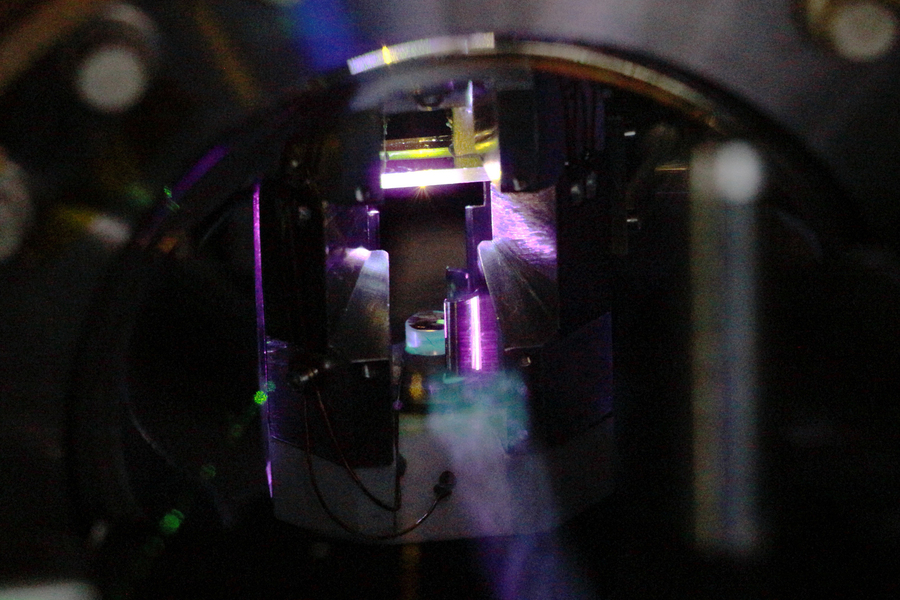创新背景
原子中的量子震荡拥有一个微小的信息世界,在凝聚态物理学中,量子振荡描述了一系列相关的实验技术,用于在存在强磁场的情况下映射金属的费米面。准确测量量子震荡并明晰它们随着时间推移而变化的形式,有助于提高原子钟和量子传感器的精度。
创新过程
量子测量的一大障碍是噪声的影响,它会压倒微弱的原子振动,令这些微妙的振动变化难以察觉。麻省理工学院的物理学家通过让粒子经历量子纠缠和时间反转两个关键过程来放大原子振动中的量子变化,相关研究成果《具有多体纠缠态的基于时间反转的量子计量学》于2022年7月发表在《自然物理学》杂志上。

给定类型的原子会以特定和恒定的频率振动,测量得当会使时间间隔比厨房时钟的秒短得多,可以作为非常精确的摆锤。但在单个原子尺度上,受量子力学定律的影响控制,原子振动就像每次翻转硬币的面一样变化,只有对原子进行多次测量才能估计其实际振荡,这种限制被称为标准量子极限。
物理学家通过多次测量数千个超冷原子振动来增加准确测量的概率制作原子钟。但这些系统仍存在一些不确定性,计时尚未达到最精确的程度。麻省理工学院莱斯特沃尔夫物理学教授Vladan Vuletic的研究小组在2020年通过实验表明,可以通过纠缠原子来提高当前原子钟的精度。通过这种量子现象,粒子被强制以集体、高度相关的状态运行。在这种纠缠状态下,单个原子的振荡会转向一个共同的频率,可以减少尝试次数来精确测量。
但具有独立粒子的线性量子测量受标准量子极限的限制,限制了估计未知相位参数时可实现的精度。测量原子振动的工具不够灵敏,读取时钟相位的能力的限制导致无法读出或测量原子集体振动的任何细微变化。

新研究采用时间反转的方式从振动的任何变化中增强信号,以便当前工具可以顺利读取。一个纯粹的量子系统应该以可预测的方式在时间上向前演化,用系统的“哈密顿量”精确描述原子振动本质上是对系统总能量的数学描述。
研究人员表示,如果在量子力学中知道哈密顿量,就可以跟踪系统在时间上的作用,就像量子轨迹一样。如果一个系统的哈密顿量被反转,并且相同的量子系统被制成去进化,就好像这个系统回到了过去。如果反转哈密顿量的符号回到过去,系统向前演化后发生的每一个小细节都会被放大。
团队研究了400个镱的超冷原子,将原子冷却到绝对零度以上,提出热量等经典效应对原子的影响,使量子效应完全控制原子的行为。通过激光系统捕获原子,会发出蓝色的“纠缠”光,迫使原子在相关状态下振动。研究人员让纠缠的原子在时间上向前演化,然后将其暴露在一个小磁场中,这引入了微小的量子变化,稍微改变了原子的集体振动。之后发送另一种红色激光,刺激原子解开纠缠,好像它们在时间上向后进化一样。

研究团队测量了粒子在沉降到未纠缠状态时的震荡,发现它们的最后阶段与初始阶段明显不同,证明它们在向前演化的某个地方发生了量子变化。研究将这个实验重复了数千次,范围从50到400个原子不等,每次都观察到量子信号的预期放大,发现实验的纠缠系统比类似的未纠缠原子系统的灵敏度高出15倍,实现了最大的相位灵敏度改进。通过时间反转进行信号放大的技术是目前为止开发的测量量子涨落的最灵敏的方法,超过了迄今为止在任何完整的纳米机械振子的物质波的Ramsey干涉仪中证明的标准量子极限。
创新关键点
创新利用量子理学的时间反转现象从原子震动的变化中增强信号,提高原子振动测量的精确度。
创新价值
该技术可以将当前最先进的原子钟的精度提高15倍,使时钟在整个宇宙年龄中相差不到20毫秒;还可用于提高检测引力波、暗物质和其他物理现象的量子传感器的精确度和灵敏度。
Quantum time inversion is used to measure vibrating atoms
One of the biggest obstacles to quantum measurement is the effect of noise, which overwhelms weak atomic vibrations, making these subtle vibrational changes imperceptible. Physicists at MIT amplify quantum changes in atomic vibrations by letting particles undergo two key processes of quantum entanglement and time reversal, and the research result " Time-inversion-based Quantum Metrology with Multibody Entangled States" was published in the journal Nature Physics in July 2022.
A given type of atom vibrates at a specific and constant frequency, and a proper measurement can make the time interval much shorter than the seconds of a kitchen clock, which can act as a very precise pendulum. But at the individual atomic scale, controlled by the laws of quantum mechanics, atomic vibrations change like the face of a coin each flip, and only multiple measurements of the atom can estimate its actual oscillation, a limitation known as the standard quantum limit.
Physicists make atomic clocks by measuring the vibrations of thousands of ultracold atoms multiple times to increase the probability of accurate measurements. But there are still some uncertainties in these systems, and timing has not yet reached the most accurate level. The research team of Vladan Vuletic, a professor of physics at Leicester Wolff at MIT, showed experimentally in 2020 that the accuracy of current atomic clocks can be improved by entangling atoms. Through this quantum phenomenon, particles are forced to behave in a collective, highly correlated state. In this entangled state, the oscillations of individual atoms turn to a common frequency, which can reduce the number of attempts to make precise measurements.
But linear quantum measurements with independent particles are limited by standard quantum limits, limiting the accuracy that can be achieved when estimating unknown phase parameters. The tools used to measure atomic vibrations are not sensitive enough, and limitations in the ability to read the phase of the clock make it impossible to read or measure any subtle changes in the collective vibrations of atoms.
The new study uses time reversal to enhance the signal from any change in vibration so that the current tool can read smoothly. A purely quantum system should evolve forward in time in a predictable way, with precise descriptions of atomic vibrations in terms of the system's "Hamiltonian quantity" essentially a mathematical description of the system's total energy.
The researchers say that if the Hamiltonian quantity is known in quantum mechanics, it is possible to track the system's role in time, just like a quantum trajectory. If a system's Hamiltonian quantities are inverted and the same quantum system is made to evolve, it's as if the system has gone back in time. If the symbol reversing the Hamiltonian quantity goes back in time, every small detail that occurs after the system evolves forward is magnified.
The team studied 400 ultracold atoms of ytterbium, cooled the atoms above absolute zero, and proposed the effects of classical effects such as heat on atoms, so that quantum effects completely control the behavior of atoms. Capturing atoms through a laser system emits a blue "entangled" light that forces the atoms to vibrate in a relevant state. The researchers let entangled atoms evolve forward in time and then exposed them to a small magnetic field, which introduced tiny quantum changes that slightly altered the atom's collective vibrations. Another red laser is then sent, stimulating the atoms to untangle as if they had evolved backwards in time.
The team measured the oscillations of the particles as they settled into an unentangled state and found that their final stages were markedly different from their initial stages, proving that they had quantum changes somewhere in their forward evolution. The study repeated the experiment thousands of times, ranging from 50 to 400 atoms, each time observing the expected amplification of the quantum signal, and found that the entangled system of the experiment was 15 times more sensitive than similar systems of untangled atoms, achieving the greatest improvement in phase sensitivity. The technique of signal amplification by time reversal is the most sensitive method developed to date to measure quantum fluctuations, exceeding the standard quantum limit proven to date in the Ramsey interferometer of the material wave of any complete nanomechanical oscillator.
智能推荐
光学创新思维 | 创新开发新型光学设备可改变单个光子的频率
2022-10-24斯坦福大学的研究人员开发了一种光学设备,允许工程师改变和微调光流中每个光子的频率,使其几乎达到他们想要的任何颜色混合物。
涉及学科涉及领域研究方向光学创新思维 | 通过孤子微梳探索光学频率梳的量子特性
2022-07-27利用孤子微型频率梳研究频率梳的量子特性,探索光学频率梳量子特性和量子纠缠的存在。
涉及学科涉及领域研究方向